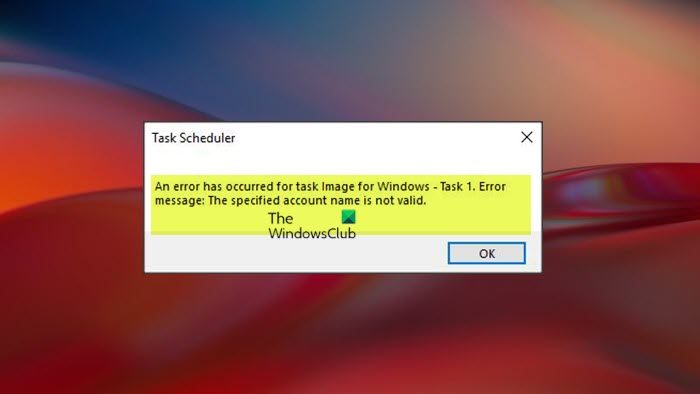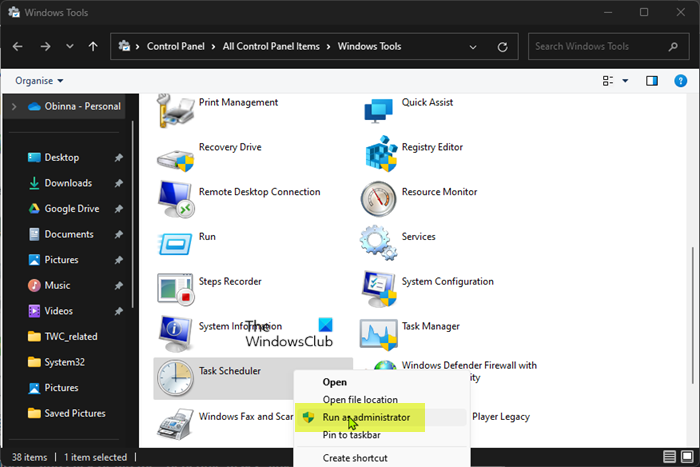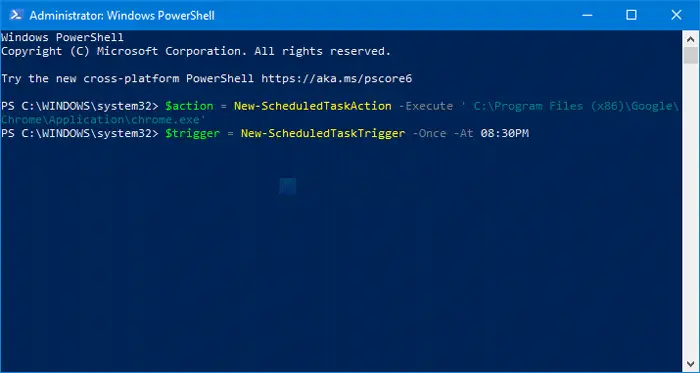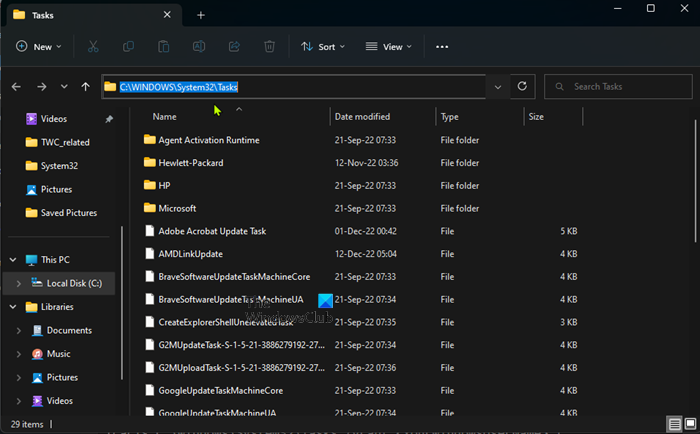Some PC users may encounter the error message The specified account name is not valid when trying to edit (eg, adding a new trigger), disable or delete an already existing task or create and save a new automated scheduled task using Task Scheduler on Windows computer. This post provides the most suitable solutions affected PC users can apply to resolve the issue easily.

You are likely to encounter this error on the system because there’s a permissions issue or insufficient rights assigned to the Windows user account or administrator account that is being used. When this error occurs on your machine, the following full error message is displayed:
An error has occurred for task <TaskName>. Error message: The specified account name is not valid.
The specified account name is not valid – Task Scheduler Error
If you have received the error message The specified account name is not valid when you try performing certain actions — for example, disable, delete or edit by adding a new trigger to a task you successfully created previously or when trying to create/save a new scheduled task from scratch using Task Scheduler on your Windows 11/10 computer, then you’re at the right place! Any of our proven and effective solutions presented below in no particular order should help you resolve this issue on your system.
- Run Task Scheduler with admin privilege
- Manually enter the path to the user account
- Troubleshoot using the inbuilt Administrator account
- Create the task using PowerShell
- Use the icacls command
- Perform System Restore
- Use a Local account
Let’s look at the description of the process as it relates to each of the listed solutions. Before you proceed with the solutions that we will describe below for you, make sure the user trying to create the scheduled task is logged in as an administrator or has been granted administrator privileges or if a standard user, have a user with admin privileges on the computer change the standard account to admin account.
1] Run Task Scheduler with admin privilege

From all indications, the Task Scheduler error The specified account name is not valid is a user account issue that could be due to insufficient, no, or inappropriate permission for the user on the system. The user requires admin privilege. So, if for some reason, the logged-in user does not have admin rights on the system, the user can run Task Scheduler with admin privilege, and then see if they can create or modify a scheduled task.
For this, the user can do the following:
- Click Start.
- Open the All apps list.
- From the list, click the Administrative Tools folder or scroll down the list and click the Windows Tools (depending on if you’re running Windows 10 for the former or Windows 11 for the latter) folder.
You can also open Control Panel, change View by to Large icons on the top right of the window, then select Administrative Tools or Windows Tools as the case may be.
- In the folder that opens, right-click Task Scheduler and select Run as Administrator.
Alternatively, you can press the Windows key + R to invoke the Run dialog. In the Run dialog box, type taskschd.msc and then press the CTRL+SHIFT+ENTER key combo to open Task Scheduler in admin mode.
Read: How to run Scheduled Task after another Task completes
2] Manually enter the path to the user account
For this task, you can first run the whoami command in Command Prompt. Whatever shows up in the output is the name that Task Scheduler is looking for – you can use that as the username and use the password that you use to log on to your Windows computer. The username that shows in the WHOAMI utility output may seem to be a truncated part of your actual username, but it should work and allow you to make and save the changes.
Do the following:
- If creating the scheduled task for the first time, and the current Windows user account isn’t working.
- Switch or change to a different administrator account.
- If running on a domain enter the domain name first (Example: domain\administrator or username)
- If running on a workgroup try entering the computer name and then the account name (example: DesktopName\Administrator or username or ServerName\Administrator or username)
- Enter the password for this account.
- Click OK.
- Switch or change to a different administrator account.
- If the scheduled task was already created and attempting to modify the currently scheduled task:
- In Task Scheduler right-click on the task and select Properties.
- On the General tab, click Change User or Group.
- Enter a different administrator account.
- If running on a domain enter the domain name first as shown above.
- If unable to find click on the Advanced Button and click Find to search the domain account.
- If running on a workgroup, enter the computer name and then the account name as shown above.
- If unable to find another user click on the Advanced button and click Find to search the computer for an alternate account. If none are present, you may have to create a new administrator profile.
- If running on a domain enter the domain name first as shown above.
- Enter the password for this account.
- Click OK.
If the above steps fail to resolve the issue, you may need to contact your system administrator to troubleshoot this issue. Some affected PC users reported they were able to resolve the issue by following this simple step:
- Edit the user account for the task to run as a SYSTEM.
- Save the task.
- Edit the task.
- Edit the user account for the task to run as the user you want.
- Finally, save the task.
3] Troubleshoot using the inbuilt Administrator account
This solution requires you to troubleshoot using the inbuilt Administrator account to isolate the issue. To do this, you need to enable the inbuilt Administrator account, then reboot your machine. On boot, login into the inbuilt admin account and see if you can successfully create/modify a scheduled task. If you don’t encounter the issue on the built-in administrator account, then it’s likely you’re dealing with a corrupt file. To confirm this, you can log into another user account that has admin privileges and see if the issue at hand persists. If so, then you need to create a new user account and then transfer your files/data from the old account to the new account or you can see if repairing the corrupt user profile solves your problem.
4] Create the task using PowerShell

Another viable solution or workaround more of, to the issue you’re currently facing, is to see if you’ll be able to edit or create the scheduled task using PowerShell without the need of ever opening the Task Scheduler graphical user interface.
Read: System Scheduler: Task Scheduler alternative for Windows PC
5] Use the icacls command

The icacls Windows command-line utility is mostly used by IT or system admins to view and as well change access control lists (ACLs) on files and folders. So, if the user doesn’t have enough access rights on the task as appears to be the case here, the issue can be fixed by using ICACLS from the command prompt in elevated/admin mode. On Windows 11/10, tasks seem to be stored in two folders:
- C:\Windows\Tasks
- C:\Windows\System32\Tasks
You’ll need to grant the required permission to the user account for the tasks in both folders. The syntax should look something like this:
icacls C:\Windows\Tasks /grant <YourWindowsUserName>:f
icacls C:\Windows\Tasks\*.* /grant <YourWindowsUserName>:f
icacls C:\Windows\System32\Tasks /grant <YourWindowsUserName>:f
icacls C:\Windows\System32\Tasks\*.* /grant <YourWindowsUserName>:f
Where the F parameter is full access (Edit_Permissions+Create+Delete+Read+Write) — make sure to replace the <YourWindowsUserName> placeholder with the actual username. If using this command didn’t work for you and the error in highlight occurs for a scheduled task that is not working the way it’s intended and you can no longer edit, disable, or delete the task, you can open File Explorer and browse to either of the directory (identified above) for Task Scheduler stored tasks, and then delete the task in question. Once done, you can launch Task Scheduler and recreate the task with the new settings.
6] Perform System Restore
If the error at hand occurs when you try to edit an already existing task or you were able to previously create new tasks until recently, then it’s likely the system has undergone some changes which may have been brought about by a new system update especially if you started to experience the issue after a recent Windows update was installed on your computer. In this case, you can uninstall any recent update or use System Restore — a recovery tool for Windows that allows you to reverse certain kinds of changes made to the operating system. System Restore is used to return important Windows files and settings—like drivers, registry keys, system files, installed programs, and more—back to previous versions and settings. That said, keep in mind that all applications and changes made before the date selected will be removed and needs to be re-installed if needed.
7] Use a Local account
This solution seemed to have worked for affected computer users that were logged in with their Microsoft account and trying to create a scheduled task. The issue was reproduced by trying to set up a scheduled task to run Windows Defender daily whilst logged in with a Microsoft account and the error occurred.
The solution was to log into a local account (you can create a local account with admin privilege) or switch from a Microsoft account to a local account on the computer and create the task. Using a local account, it appears one of the settings can run even if not logged in — a possible explanation is that the Microsoft account has a domain (public or private) as its email address and that seems to cause a security problem, and using a local account allows you to work around the issue.
If you had migrated to a Microsoft account from a local account, it’s likely your user directory is still in the name of the local account. In this case, what worked according to some affected users is to use the Microsoft account password to log into the local account and you should now be able to create or modify any scheduled tasks on the system.
Hopefully, you find this post helpful!
How do I fix Task Scheduler not working?
If Task Scheduler is not running, triggering, or starting programs on your Windows 11/10 computer, amongst other potential fixes, you can first ensure the Task Scheduler service is running. Open the Services manager. Find and double-click to open Task Scheduler Properties. Ensure that the Service status is Running. If it is not running, you need to set the Startup type to Automatic. Then click Start > Apply > OK to turn on the Task Scheduler service.
How do I change my username in Task Scheduler?
To change your username in Task Scheduler for a task on your Windows 11/10 computer, simply open Task Scheduler, then double-click Scheduled Tasks. Now, find and then right-click the name of the scheduled task you want to modify select Properties and select the Task tab. In the Run as box, type the account name to use and save changes.
Read next: One or more of the specified arguments are not valid Task Scheduler Error
Leave a Reply